What on earth could be happening under those umbrellas? And where is this busy scene happening?
Hey, it's Ben. And welcome to Kokooland1.
When I introduced this series, I thought I’d follow up by jumping right into telling you about a person and their relationship with cocoa.
But then I thought: ‘Hmm, that won't help much.’
You see, for you to truly relate to the experiences described in my stories, a sense of what it’s like to live in a cocoa-growing environment will go a long way.
So, in this letter, I want to achieve one thing: give you a feel of one of the contexts cocoa farmers live in. How?
I’ve chosen a town where many cocoa farmers live, and I’ll take you on a photo walk to experience how life happens there.
But, before we step outside, let's zoom out and look at the world map for some… erm… geographical orientation.
First, here’s a map of Kokooland.
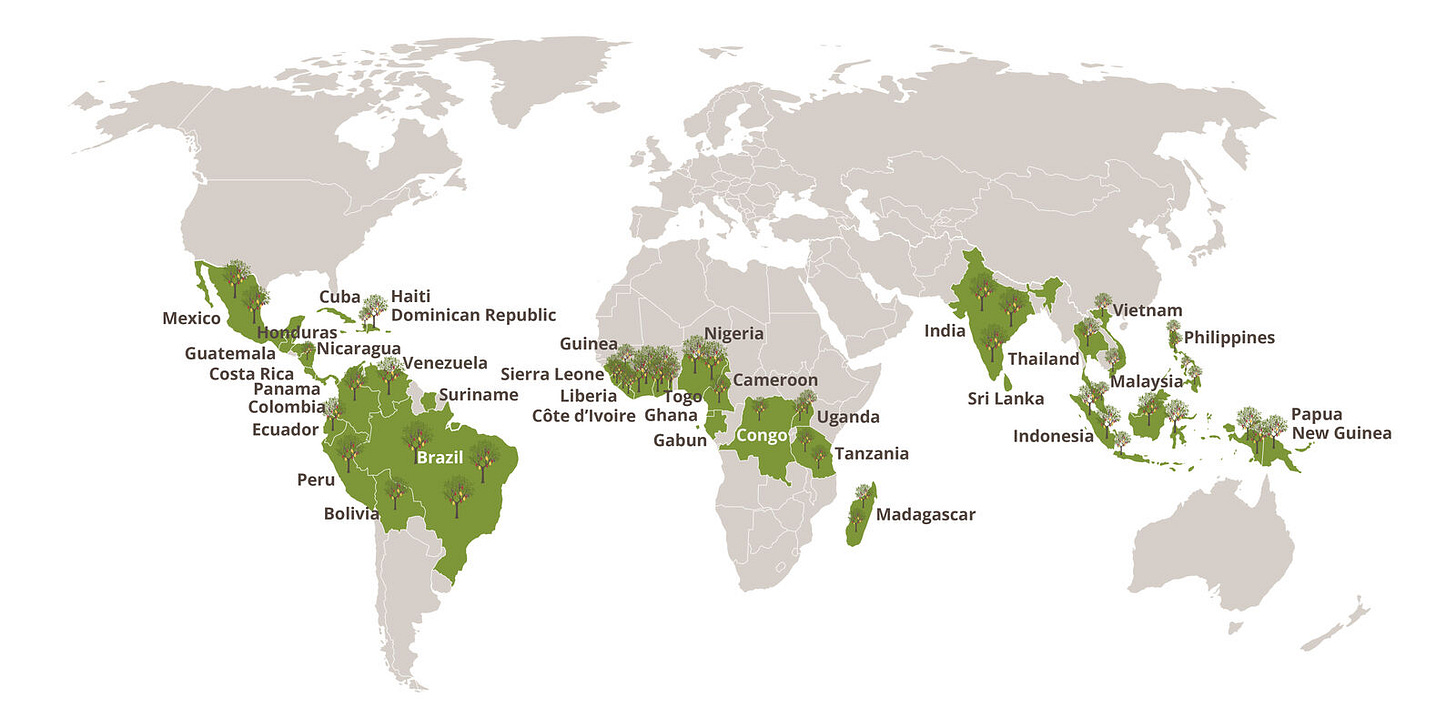
All the green countries are within 10° North and 10° South of the equator. They have the most favorable climate on the planet for the cocoa plant to thrive.
👋 Hey! Can you tell how far you live from the nearest country in Kokooland?
But this map is quite abstract. Let’s zoom in to Central Kokooland aka…
Africa.
About 74% percent of the global cocoa supply comes from here, although it is not the original home of cocoa (cocoa is originally from South America aka Western Kokooland).
You can see the green tropical areas - the comfort zones of cocoa - come alive.
But this map is still zoomed out. We can’t see anything alive yet. Let’s get closer and look at…
West Africa
West Africa is popular in the cocoa industry because Ivory Coast and Ghana - the top two cocoa producers and neighbors - are here.
On the map, it’s clearer now how the green forest zone contrasts with the large brown space up north where its mostly savanna leading into the Sahara Desert.
At this point we’re close to something lively. Let’s zoom in further to one country in West Africa. And that would be…
Ghana.
Ghana used to be the highest global producer of cocoa. Until 1978 when Ivory Coast took over.
On the map, you can see there's a lot of green in the south, and then it fades into brown up north. That’s because Ghana’s forest zones are in the south and hence it’s the hub of cocoa production.
Don’t you think Ghana has a beautiful map? I don’t know how to describe it, it just feels unique.
Anyway, Ghana is still too big - 238,533 km² or thirty-three billion football pitches. And it’s divided into sixteen regions, further split into 261 districts.
So, let's zoom in further to one region:
Eastern Region
Ghana’s cocoa production started in this region, and then it spread to other places in the country’s forest zones.
Finally, welcome to Asamankese.
It is here on the outskirts to the west that, right now, I’m typing this letter. Yes, Asamankese is my home.
It’s the capital of the West Akim Municipal District. And as the bigger town, it connects many rural communities to the Accra, Ghana’s capital city.
As you can see, Asamankese is surrounded by lots of farmland (the greens). Smallholder farmers here grow cocoa and other crops on the outskirts. Some of them you’ve met before, others you'll meet in future letters.
📌Aside: If your imagination of what a farm should look like from above is different from what is on the map, don’t worry. That’s why I began this series. We’ll explore it in a future letter.
Now, dear friend.
Enough of the maps. Let's hit the ground and walk around.
There are a million scenes to see. But let’s explore a few photos to give you a feel of the streets here.
First, here’s a view of the township from a hilltop on our way to the town center.
I like to see the old brown roofing sheets endure as the younger blue ones pop up.
Now let’s walk down to the town centre in the afternoon. Here are some hot afternoon scenes:
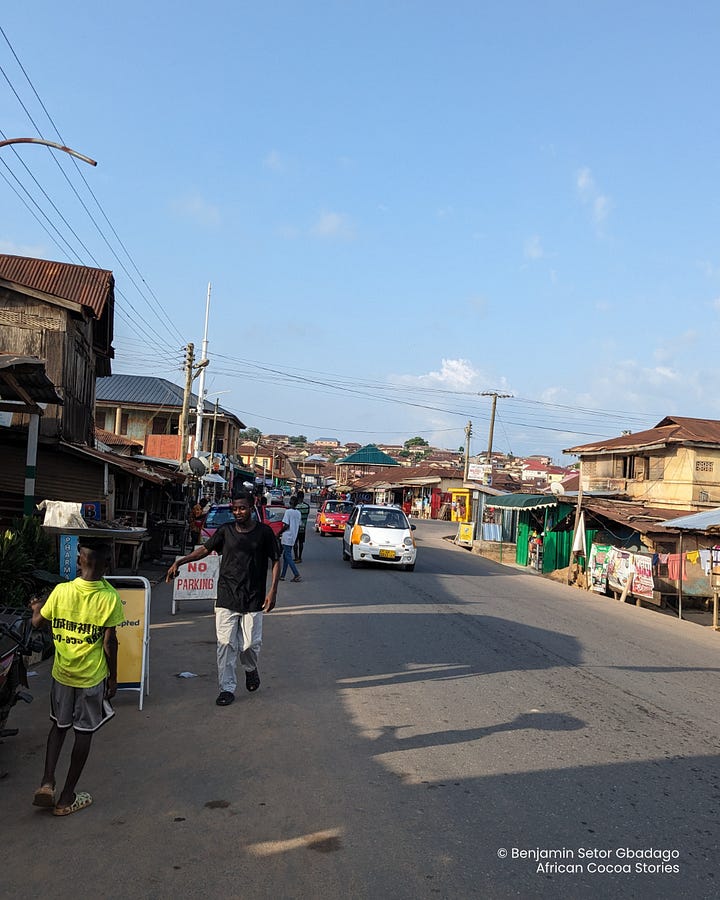
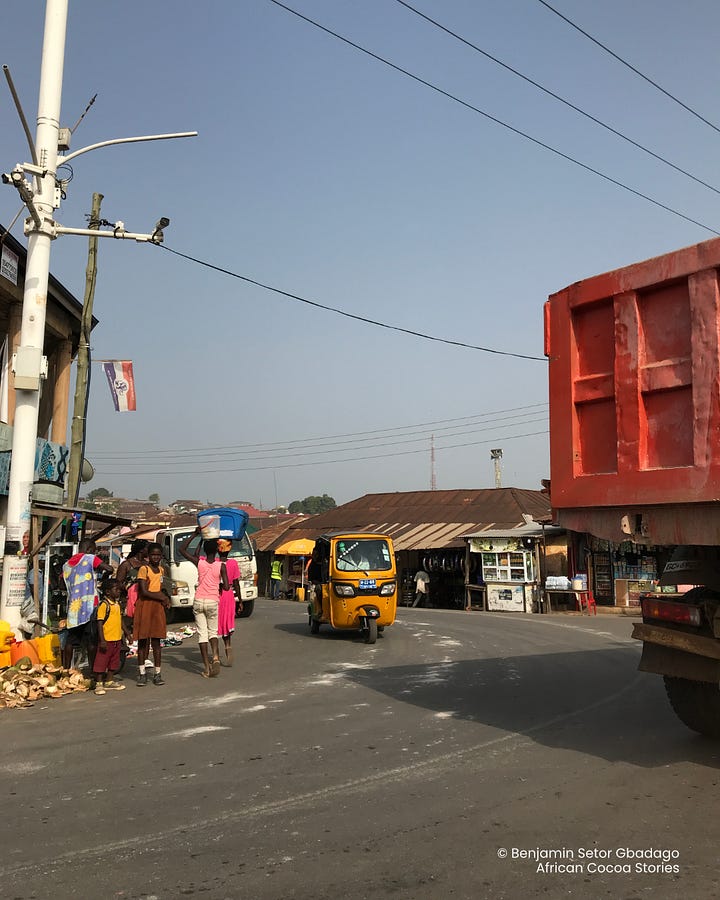
This beautiful scene below makes me smile. No traffic lights. No zebra crossing. Just pedestrians, drivers, and riders negotiating their way around.
And about the umbrellas, each one is a temporary shop that pops up mostly on Mondays and Thursdays, which are market days. Under an umbrella, you can buy a keyholder. Or avocado. Or Cassava. Others even sell shoes or clothing.
👋 Fun fact: A yellow number plate means the vehicle is for commercial passenger transport.
Now, let’s move away from the town center. Let’s walk along the highway towards the outskirts of town where - my neighborhood.
You’re likely to pass by a farmer on their way to or returning from the farm. They could be cocoa farmers. You never know.
If we stop for a while in front of this red building below, we’ll see the kids marching home from school.
Maybe it’s nostalgia. But I love seeing kids with their big backpacks going to school.
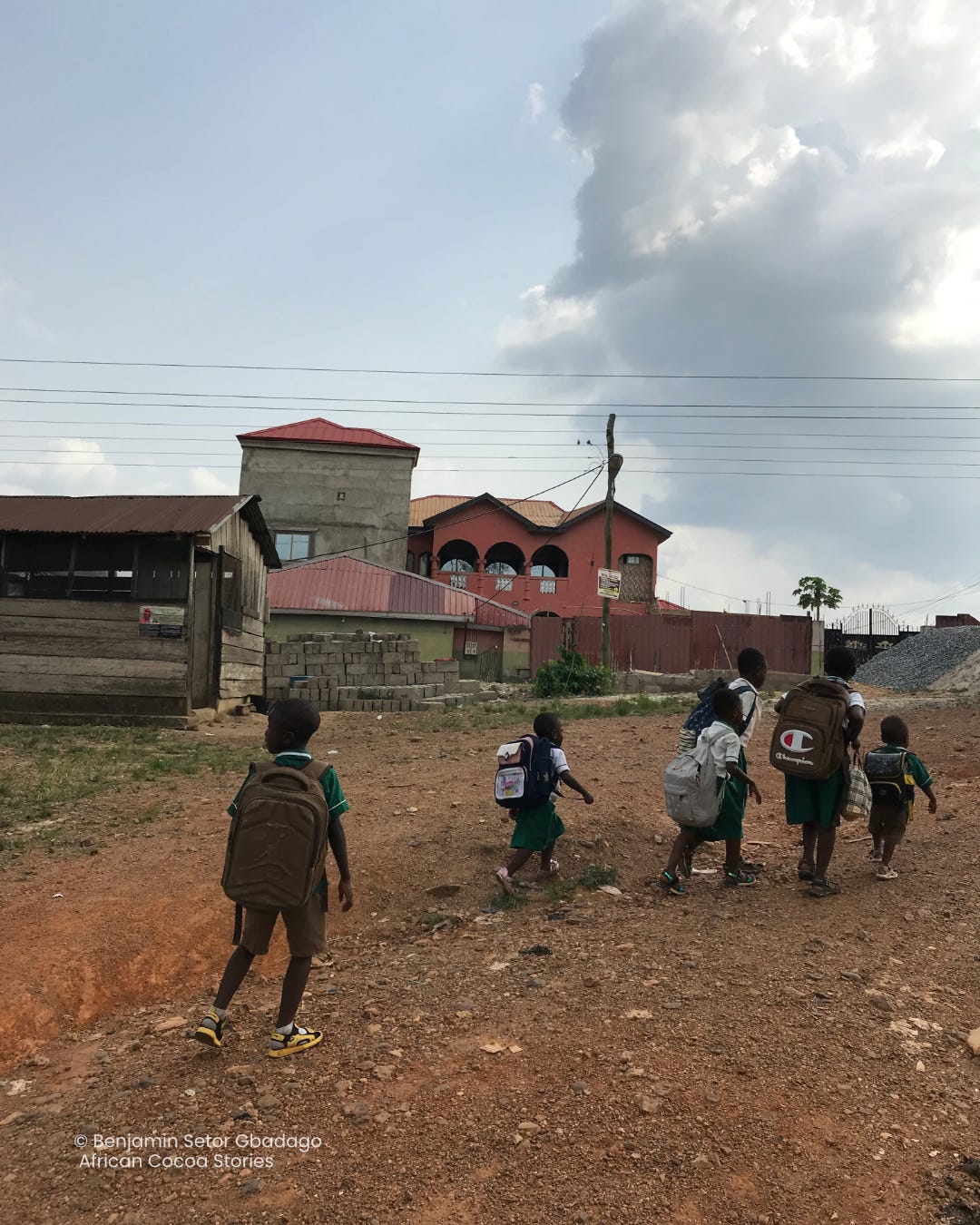
My house is just a block behind this red house. But let’s hang around the junction a little bit. We’ll see the men carrying eggs from the poultry farm in the neighborhood.
Finally, let’s take the street that goes behind the red building toward my house. We’ll see more kids like these two ‘riding’ a broken bicycle.
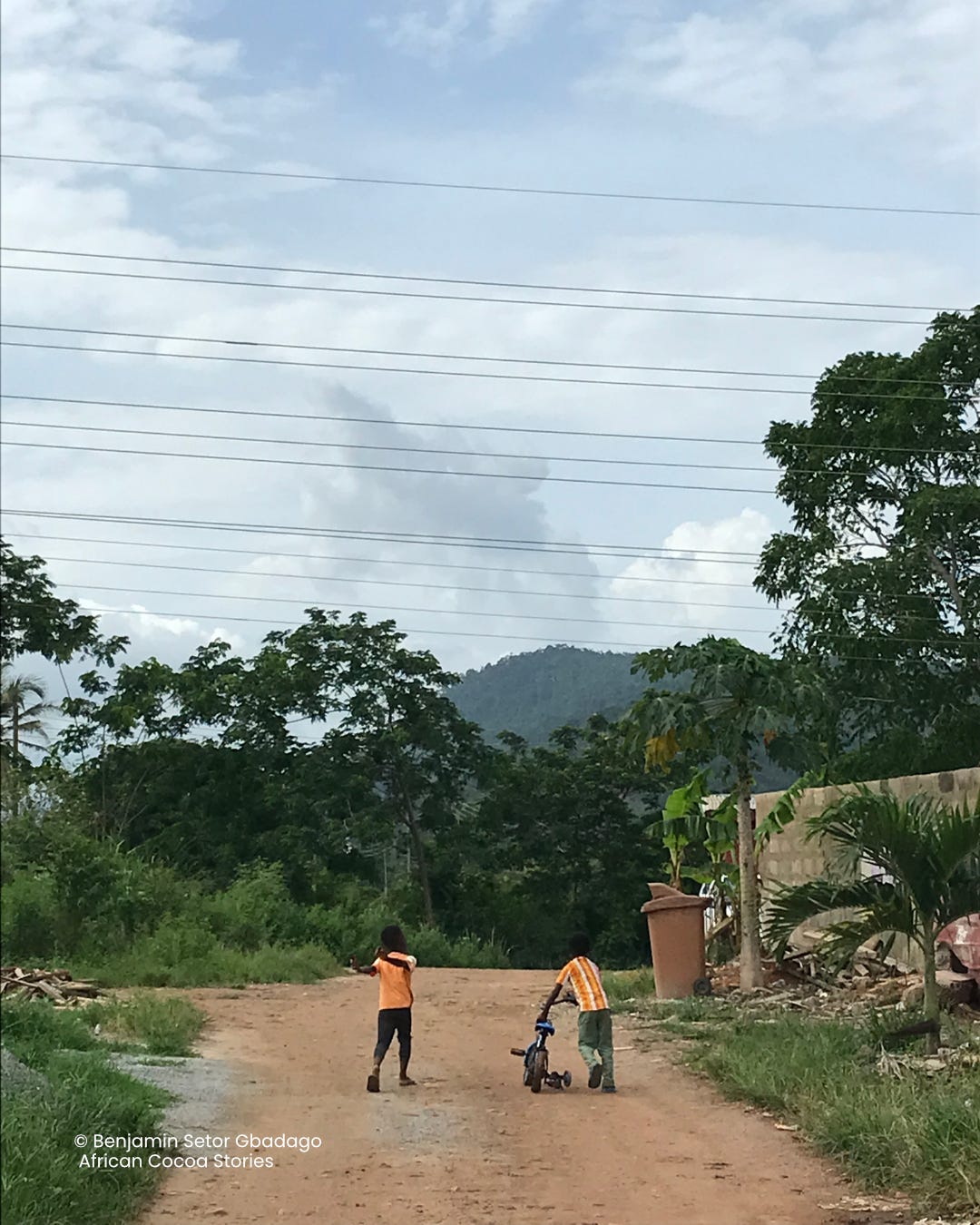
Sometimes a goat is chewing on leaves in a maize plantation. Yes, we can have small maize plantions in the neighborhood. And yes, the goat is not for the farmer.
And it’s a wrap!
Our first tour of a Asamankese, a town in Central Kokooland (Africa) ends here. My goal was to bring you into one of the many cultural contexts cocoa production is embedded in. I hope you enjoyed the tour.
If these scenes have triggered a thousand questions in your mind, I’ve reason to be happy. Because with your questions, we can have discussions and explore many interesting topics.
So, send me your questions, and let’s get talking. I’m not here to lecture, but to facilitate a conversation.
Thanks for walking with me. If you missed the intro to the series, here’s it:
Welcome to Kokooland
When I started this newsletter, my desire was to bring curious chocolate lovers like you into the cocoa production world.
Thanks, and see you in the next one!
-Benjamin
credits: James Cofie, and Matthew Beebe read this draft.
Kokooland (Cocoa Land) is our shortcut term for all the parts of the world where cocoa comes from. This series is about meeting the people there and learning about their culture as I explore. And our focus will be on the African side aka Central Kokooland. Kokoo is the local Ghanaian word for cocoa or cacao.















…really cool to see where you live…i am so far away…i’m curious about what the day to day is for most folks in your city…is cocoa production the main work or are other industries present?…what is the local nature like?…and what are the leisure activities in town…as well as the local cuisine?…
I love this!! Thanks so much for sharing!